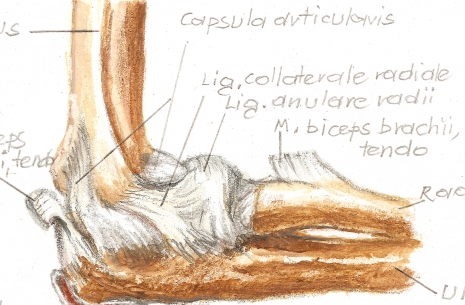
Armwrestling is not only about skills, strength and technique, it’s also caring for your bone / joint structure. Prophylactics play a major role here, especially concerning joint cartilage. ()
Armwrestling is not only about skills, strength and technique, it’s also caring for your bone / joint structure. Prophylactics play a major role here, especially concerning joint cartilage. It has a major impact on joint function. In armwrestling, this is especially important in the case of the elbow joint. Until recently, joint cartilage degeneration was mainly a domain of the old, but now we know this is also the case with sportspeople. Here’s some information that every armwrestler should know about joint cartilage.
JOINT CARTILAGE is a unique type of cartilage. It covers joint surfaces, which are prone to friction, pressure and stretching during movement. Mostly it is hyaline cartilage, with exception of joints, where fibrous cartilage prevails. It is smooth, shiny, elastic and very immune to friction. At the same time it’s sensitive to pressure and stretching that take place at great strains (intensive training, physical labour). Joint cartilage doesn’t have perichondrial cover – it’s not nerved and doesn’t have its own blood system. Thus it cannot regenerate. In practice, damaged joint cartilage just doesn’t regrow. It’s nurtured mainly by joint fluid. Thanks to its elasticity it can shape itself to fit uneven joint surfaces.
ROLE OF JOINT CARTILAGE
Joint cartilage has many roles. It protects bone ends inside the joint from pressure, adjusts joint surfaces, buffers shocks and traumas, and facilitates movements.
DAMAGE TO JOINT CARTILAGE
As a result of strain on the joint surface, hyperfriction is applied to the surface of hyaline cartilage on bone structures. This leads to degradation of cartilage as a result of wearing down of joint surfaces, deprived of sufficient lubrication by joint fluid.
Joint fluid: (latin: synovia) – substance manufactured in synovial membrane in order to lower friction in joints by lubricating cartilaginous surfaces.
RADIOLOGICAL CRITERIA OF JOINT CARTILAGE DEGRADATION
narrowing of joint gap
cysts in sub-cartilaginous bone
osteophytes (bone peaks, protruding from various points of the joint)
change in shape of joint bones
calcification around the joint
PROPHYLACTICS
To prevent degeneration from large axis pressures, supplementation with glucosamine is recommended. It is a natural substance that stimulates joint cartilage regrowth and eases joint pains. Let’s take a closer look at this amino sugar.
Glucosamine appears naturally in our bodies and is a component of proteoglycans (protein-sugar compounds). These compounds build cartilage, make it tough and elastic. Cartilage doesn’t have blood vessels, and its nurture is facilitated by joint fluid that contains glucosamine.
As we can see, glucosamine not only builds cartilage, but also provides it with nutrients. Both functions can be used to stimulate regeneration of damaged cartilage. Supplementation with glucosamine stimulates joint cartilage cells to rebuild proteoglycans, thus strengthening the cartilage. Administered orally, glucosamine is easily absorbed into the cartilage, where it triggers regenerative processes.
Gradual rebuilding of cartilage influences the capability of the joint and eases pain. When administered as therapy, doses should be increased for a minimum of 2 weeks. As a prophylactic, take smaller doses to stimulate joint fluid production. It’s recommended to use sauna as an aid to improve joint mobility and increase the circulation of joint fluid.
Armpower Editorial Staff
With cooperation of Aleksandra Zwolak



Archive >>>
Basics of armwrestling: tying the strap, injuries
Dreamed of being a general, became an armwrestler
TOP 10 supplements in armwrestling
Last week's most popular articles